Repotting cannabis plants correctly and everything you need to know about it
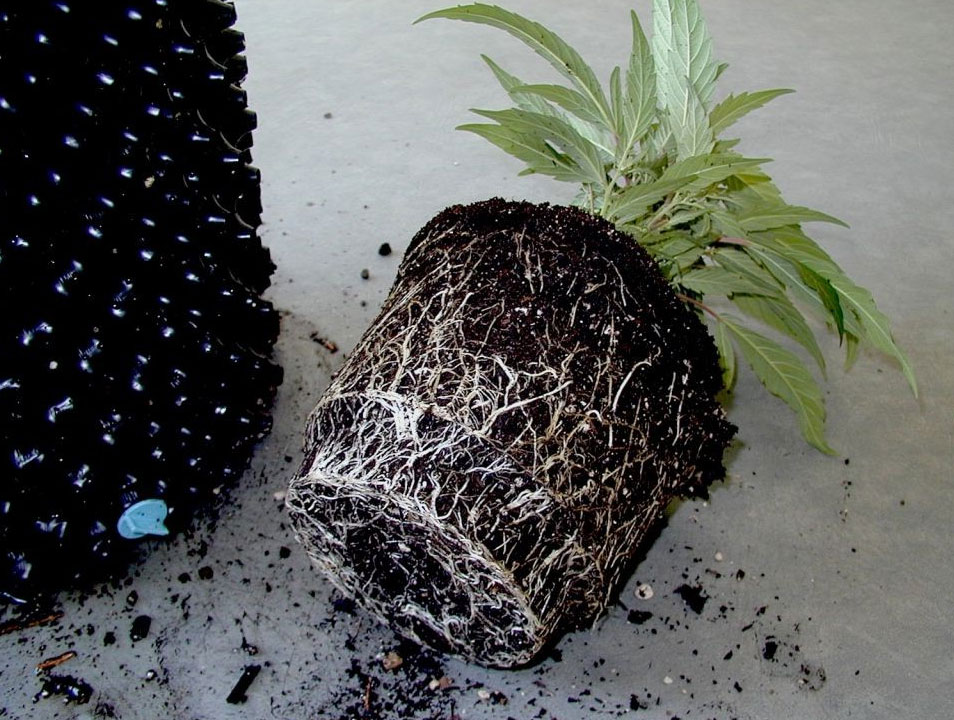
When cannabis plants become too large for their plant pot, they need to be repotted to ensure continued healthy and rapid growth. A densely packed and overly entwined root system in the plant pot will produce weak and stunted growing cannabis plants with thin branches.
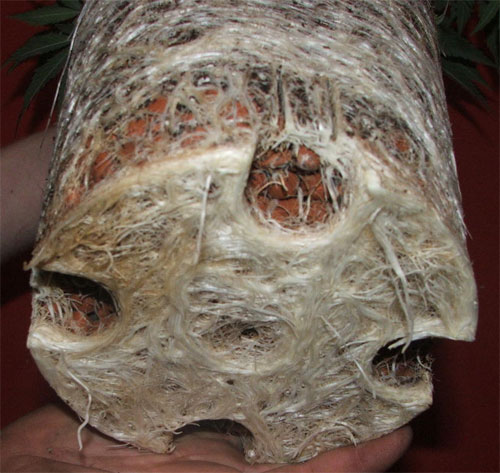
To check the roots of the cannabis plants, carefully take them out of their planter. Then you can easily see to what extent roots are already growing densely, in several layers and circularly along the bottom of the pot.
Cannabis plants that are kept smaller, grown indoors or autoflowering plants usually get by with a final pot size of 11-19L. Larger plants or mother plants that stay in their pots for more than 3 months get correspondingly larger planters.
When growing outdoors, the marijuana plants usually grow much larger than when grown indoors. Outdoor plants should therefore be given the largest possible planters in order to develop a strong and widely branched root system. Large plants that produce high yields of 4kg and more of medical marijuana are placed in 700-2000L planters.
Rockwool blocks planted in soil hold more water than the soil can hold. As a result, the roots grow slowly into the soil. It works best if small stone blocks are placed in soil. The small stone cubes can only hold a little water and the roots grow faster into the soil. When repotting, the soil should be moist and the rock wool block slightly moist to promote root growth as much as possible.
When starting with seeds in rockwool blocks or cubes, the transplanting that follows after some time is relatively easy. Simply fill a sufficiently large new pot with good cannabis soil, make a small hole in the centre of the planting medium and place the cube in this, cover the surface with soil and press down carefully and lightly, done. After planting, the planting medium should be kept evenly moist.
The roots of cannabis plants are sensitive. When repotting, they can easily be damaged by light and careless hands, for example. Therefore, they should be handled with care. Normally, the roots are in a dark and protected environment. If they are taken out of their pot and lack contact with the soil or a hydroponic medium for too long, they will dry out and die.
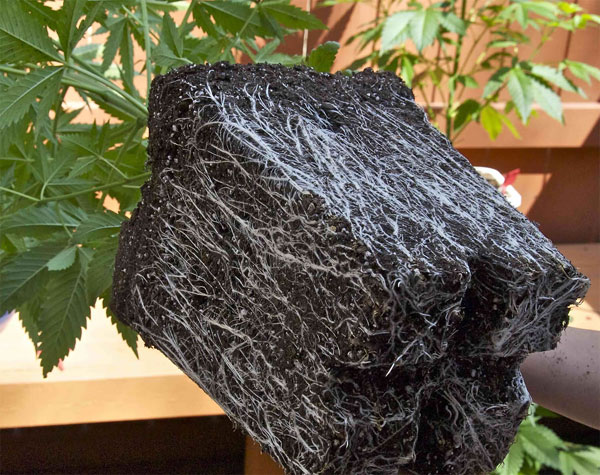
When repotting, it is best if the roots are stressed or disturbed as little as possible. After transplanting into a new pot, chlorophyll production and photosynthesis initially slow down. The uptake of water and nutrients is also slowed down. For 2-3 days, the plants should be exposed to slightly less intense light (not the best place under the NDL) or not to direct sunlight.
Repotting is always a bit stressful for cannabis plants and should be done at a point when the plants are as healthy and strong as possible. If a plant is suffering from root-bound, it will usually enjoy and benefit from repotting. Additives with Trichoderma and Mycorrizha fungus, such as ......, help to reduce the repotting stress on the plants and encourage further growth. The cannabis plants need some time after repotting until they have regenerated and their water balance has returned to normal.
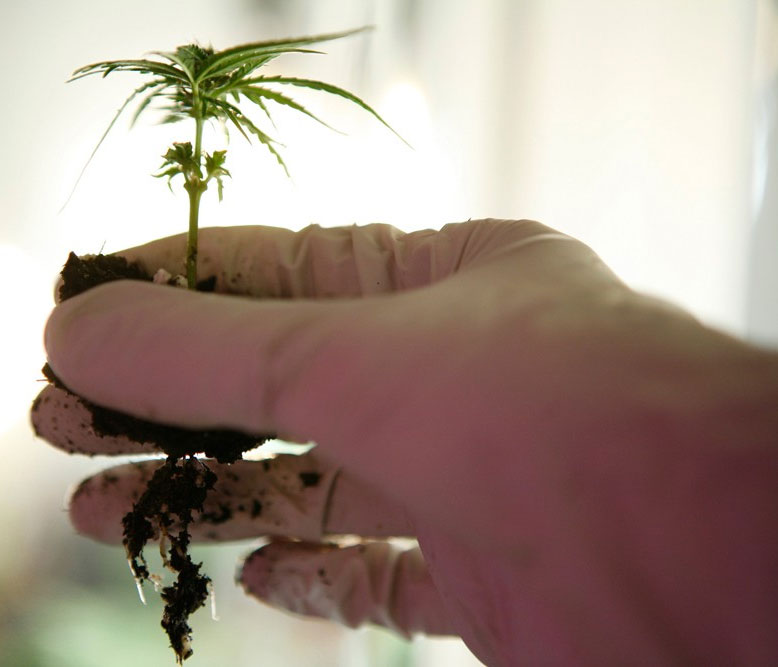
If the plants are placed in a new pot carefully and without much disturbance to the roots and the remaining plant, the shock to them will be minimal.
To get the roots to grow thick and strong, repot only when the cannabis plants have filled their previous pot well with roots.
If cannabis plants get a 3-4 month growing period in full sun, the roots of 1-2 outdoor plants can fill an 800L planter without problems. If the large plants start to grow too much into each other and shade themselves too much, clever tying down and the use of netting is required But back to the topic....
Large planters generally need less attention than small ones, do not need to be watered as often and can store more nutrients.
Repotting cannabis plants step-by-step
Step 1:
The day before the cannabis plants are repotted, they are fertilised with only a weak nutrient solution containing Trichoderma and mycorrhizal fungus.
Mycorrizha and Trichoderma help avoid repotting stress and ensure healthy growth
Step 2:
Fill the new, larger plant container to a few cm below the rim with high-quality soil (or another planting medium). Then water the medium with a light organic nutrient tea, e.g.: Mother Earth from Advanced Nutrients or a weak nutrient solution with mineral fertiliser. Dig a hole in the centre of the plant pot that is the same size as the previous planter.
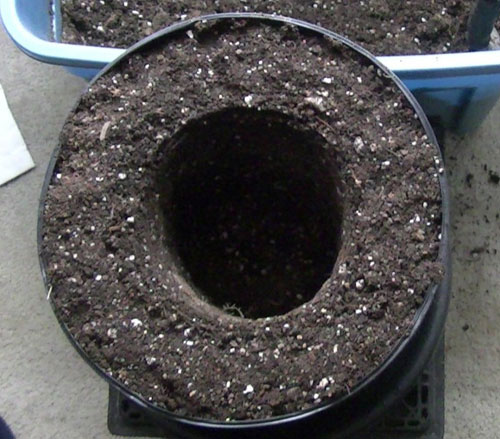
Step 3:
Carefully remove the root ball from the planter. To do this, place your hand over the pot and hold the main stem between your fingers. Now turn the pot downwards so that the plant hangs down. With one hand, carefully and slowly pull the pot upwards away from the root ball while letting the plant slide into the other hand. Sounds complicated.......... but it is not. It is important that the root ball remains in one complete piece.

Step 4:
The root ball is now placed in the prepared hole in the new larger pot. If necessary, add some soil and press down lightly so that the old and new soil are combined. For outdoor and also indoor plants, a mulch layer of e.g. hydro-correls can now be made. Water the repotted plant with a weak nutrient solution containing Trichoderma and micorrhizal. The soil should be moist, but not dripping wet, and water should always be able to drain out of the drainage holes at the bottom of the pot.
If different media are available, i.e. if a rockwool block is to be planted in soil, pay some attention to soil moisture and make sure that the rockwool block is only slightly to barely moist before it is placed in the soil. This way the roots will move more quickly into the new medium in search of more water.
Marijuana plants repotted quickly and safely
If several or even many plants are to be repotted, it is easiest to fill the new planters with good new soil beforehand. Simply take an empty plant pot that is the same size as the previous pots. This serves as a placeholder to get the right planting hole and is placed in the larger new pot. Then fill the space between the large pot and the placeholder pot with soil and press down lightly. The space is filled to just below the rim of the pot, immediately before a plant is placed in this new pot, the small pot that served as a placeholder is removed and the plant is placed directly in the hole. This can save a lot of time, the roots are only exposed to light for a short time, which in turn means less plant stress.
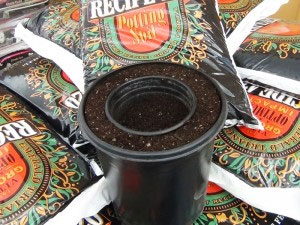
The most important tips for repotting
- the soil should not be pressed too firmly into the pot. Roots can then only spread with more difficulty and the soil climate is not ideal. The soil should also not be too loose in the pot, because otherwise it will "collapse" when watered, become more compact and then the pot will only be half full. A middle ground is perfect.
- Water plants immediately after repotting. The first watering after repotting ensures that the soil settles and settles around the roots. It helps especially young plants to cope with the stress.
- Do not repot in direct sunlight. Roots do not like direct light. Neither do they like dryness. It is best to repot in the early morning or evening.
- Especially if you have used fresh All-Mix or another rich soil, no additional fertiliser should be applied for the next 3 weeks because the soil already contains all the important nutrients.
Repotting marijuana plants requires a little patience and careful handling of the roots. Take your time and look forward to a thick harvest.
Age of the plant
Pot size
1-3 weeks
3L pot
3-6 weeks
4-11L pot
6-8 weeks
4-11L pot
2-3 months
19-35L pot
3-6 months
180-800L pot
6-9 months
1500-2000L pot
Age of the plant
Pot size
1-3 weeks
Rockwool cube/small pot
2-6 weeks
3L pot
6-8 weeks
7-8L pot
2-3 months
11L pot
3-8 months
19-25L pot








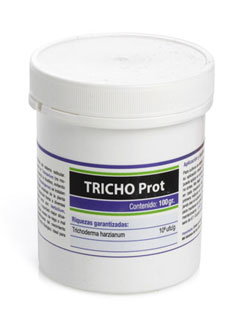
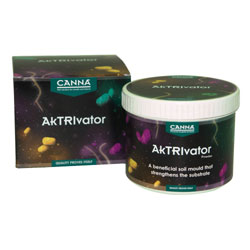
I don't repot at all, but sow 3 seeds directly in one (1) 4.5 litre pot - but my grow strategy took too long to execute and actually I'm here to give your 1000seeds page 10 out of 10 stars in general. Very informative, 1 a usability, clearly structured, visually very appealing and in general. The best cannabis page I have seen so far!